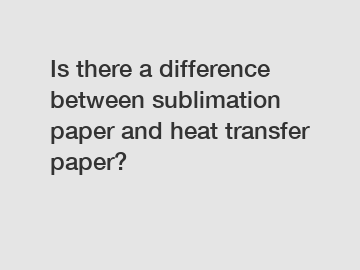Dec. 23, 2023
Packaging & Printing
Is there a difference between sublimation paper and heat transfer paper?
When it comes to customizing designs on various surfaces, using the right transfer method is crucial. Two common options are sublimation paper and heat transfer paper. While they may seem similar at first glance, there are distinct differences between the two. In this article, we will explore these differences and help you understand which method suits your needs best.
Understanding Sublimation Paper:

Sublimation paper is a special type of paper coated with a heat-sensitive polymer. It is primarily used in the sublimation transfer process, where ink is first printed onto the paper and then transferred onto a substrate using heat. The ink undergoes a phase change from solid to gas without turning into a liquid, resulting in a permanent and vibrant image on the substrate.
Sublimation paper works effectively with polyester or polyester-coated surfaces, as the process relies on the dye molecules penetrating the polyester fibers. The heat causes the pores of the polyester to open, allowing the dye to bond with the material. As a result, sublimation prints are highly durable, resistant to fading, and have a soft, breathable feel.
Understanding Heat Transfer Paper:
Heat transfer paper is another popular choice for customization projects. Unlike sublimation, heat transfer paper relies on a different type of ink that does not undergo a phase change. The ink sits on top of the paper and bonds with the substrate upon application of heat and pressure.
Heat transfer paper can be used on a variety of surfaces, including cotton, polyester, and blends. This versatility makes it a preferred choice for projects like t-shirt printing. With heat transfer paper, you have the option to choose between two types: light-colored and dark-colored transfer paper. Light-colored transfer paper is designed for use on white or pale-colored fabrics, while dark-colored transfer paper is specifically made for use on dark-colored fabrics.
Differences Between Sublimation Paper and Heat Transfer Paper:
1. Compatibility: Sublimation paper is primarily used with polyester or polyester-coated surfaces, while heat transfer paper can be used on different substrates, including cotton.
2. Durability: Sublimation prints are known for their durability, as the ink becomes a part of the fabric, resisting fading and cracking. Heat transfer prints can also last a long time, but they may not be as durable, especially on washable fabrics.
3. Feel: Sublimation prints have a soft, breathable feel because the ink bonds with the fibers. Heat transfer prints can feel slightly on the surface, as the ink sits atop the fabric.
Which Method Should You Choose?
The choice between sublimation paper and heat transfer paper depends on your specific requirements. If you primarily work with polyester or polyester-coated surfaces and desire highly durable and vibrant prints, sublimation paper would be the ideal choice. On the other hand, if you work with various surfaces and need great versatility, heat transfer paper can cater to your needs effectively.
In conclusion, while both sublimation paper and heat transfer paper allow for customization, the differences lie in compatibility, durability, and feel. It is essential to consider your materials, intended use, and desired outcome before selecting the appropriate transfer method.
Need assistance with your customization projects? Feel free to contact us for expert advice and high-quality printing solutions. Our team is readily available to provide guidance and ensure you achieve the best results with the chosen transfer method.
For more information, please visit transfer printing paper for polyester, quick dry sub paper, buy sublimation paper online.
Previous: Ultimate Guide: Why Flat Bottom Pouches Dominate Packaging Trends?
Next: What are the different types of flasks used in chemistry?
If you are interested in sending in a Guest Blogger Submission,welcome to write for us!
All Comments ( 0 )